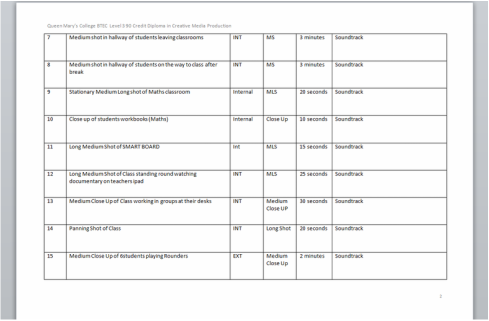5 Essential Production Paperwork Tips for Efficiency

In the bustling world of film production, the mantra “time is money” resonates deeply. Every aspect of the process, from pre-production to post-production, demands meticulous planning and organization. This is where production paperwork comes into play. It’s not just about the documents themselves, but how effectively they are managed. Here are five essential tips to streamline your production paperwork for efficiency.
Utilize a Comprehensive Production Management System

The foundation of efficient paperwork management in film production is a robust production management system (PMS). This system can be either a specialized software or a well-structured method of handling documents.
Why is this important? - A PMS automates mundane tasks, reducing human error. - It provides a centralized location for all documents, ensuring everyone has access to the latest versions. - Real-time updates and alerts help manage timelines and keep track of key deliverables.
Steps to Implement a PMS: - Choose the Right Software: Look for software tailored to film production, like Scenechronize or Celtx. Ensure it integrates well with your team’s workflow. - Staff Training: Make sure your team is comfortable using the system. Hold workshops or training sessions. - Set Up: Organize documents in a logical manner. Categories could include: - Schedules - Call Sheets - Scripts and Sides - Budget and Cost Reports - Crew and Cast Contact Lists - Permissions and Release Forms
Integration with Existing Workflows: - Integrate your PMS with accounting software for seamless budget tracking. - Sync it with casting and talent management tools to keep everyone’s contact information up to date.
🛠 Note: Integration might require initial setup and learning, but it will pay dividends in long-term efficiency.
Implement Digital Signatures

Gone are the days of waiting for physical signatures on paper contracts and agreements. Digital signatures are the future of paperwork efficiency in film production.
Why Go Digital? - Speed: Get documents signed and returned much faster. - Security: Digital signatures are legally binding and offer high levels of security. - Accessibility: Documents can be signed from anywhere, reducing delays due to travel or time zone differences.
Steps to Implement Digital Signatures: - Select a Signing Service: Services like DocuSign or Adobe Sign are popular choices. - Educate Your Team: Explain the benefits and legal implications of digital signatures to your team. - Set Up Your Documents: Identify all documents that require signatures (e.g., contracts, release forms). - Integrate with PMS: Ensure your chosen signing service integrates with your production management system for a seamless workflow.
What to Look For in a Signing Service: - User Interface: It should be intuitive for signers, especially those not tech-savvy. - Mobile Compatibility: The ability to sign documents from smartphones or tablets is crucial. - Legal Compliance: Check that the service meets the electronic signature laws in your jurisdiction.
🔒 Note: Ensure the digital signature service you choose complies with international electronic signature regulations like eIDAS for EU operations.
Standardize Templates

A lack of standardization can lead to confusion and inefficiency. Standardizing templates for frequently used documents streamlines the process.
Why Standardization Matters: - Consistency: Ensures all documents convey the same format and branding, reducing errors. - Speed: Pre-filled templates speed up the document creation process. - Clarity: Well-designed templates provide clear instructions, minimizing errors in completion.
Creating Standard Templates: - Identify Common Documents: Create templates for call sheets, shooting schedules, crew lists, release forms, etc. - Design for Clarity: Use clear language, headings, and bullet points. Include fillable fields where necessary. - Review and Feedback: Get input from various departments to ensure the templates meet everyone’s needs. - Version Control: Set up a system to track and update templates, ensuring all team members use the most current version.
Tips for Effective Templates: - Automate Where Possible: Utilize features like date auto-fill or dropdown menus for repetitive entries. - Visual Consistency: Use company colors, logos, and branding for a professional look. - Accessibility: Design with accessibility in mind, ensuring legibility for all.
Embrace Paperless Production

In today’s eco-conscious and tech-savvy world, moving towards paperless production not only benefits the environment but also boosts efficiency.
Benefits of Going Paperless: - Reduced Clutter: Minimize physical document storage needs. - Searchability: Documents can be easily searched by keywords or phrases. - Collaboration: Team members can collaborate on documents in real-time. - Backup and Recovery: Digital files can be backed up, reducing the risk of loss.
Steps to Transition to Paperless: - Digital Distribution: Send out documents via email, secure file sharing services, or through your PMS. - Cloud Storage: Utilize cloud services like Google Drive, Dropbox, or Microsoft OneDrive for document storage. - Implement Electronic Consent: Ensure team members are comfortable with electronic consent for all communications. - E-Signatures: Fully integrate digital signatures to replace paper-based signing.
Challenges and Solutions: - Resistance to Change: Educate your team on the benefits and provide support during the transition. - Security: Implement strong security measures, including encryption and two-factor authentication. - Offline Access: Have offline solutions for locations with limited internet access, like pre-downloaded documents.
Table: Key Paperless Tools and Their Functions
| Tool | Function |
|---|---|
| Google Drive | Cloud storage and document collaboration |
| Dropbox | Secure file sharing |
| Adobe Sign | Digital signatures |
| Scenechronize | Production management with paperless features |

Regular Audits and Streamlining

Efficiency in production paperwork isn’t a one-time setup; it requires ongoing audits and refinement.
Why Conduct Regular Audits: - Spot Inefficiencies: Identify redundant processes or documents. - Improve Security: Review access levels and document security measures. - Ensure Compliance: Keep up with legal and industry standards.
Steps for Conducting Audits: - Review Documentation: Evaluate current forms and templates for relevance and efficiency. - Feedback Loop: Get input from crew members about what works and what doesn’t. - Analyze Workflow: Use tools like flowcharts or process mapping to visualize and optimize document flow. - Implement Changes: Make adjustments based on audit findings, focusing on reducing unnecessary paperwork and enhancing usability.
Key Areas to Audit: - Access Control: Who has access to what documents, and is it necessary? - Workflow Efficiency: Are documents moving through the production pipeline smoothly? - Compliance: Are all necessary documents in place for legal protection?
🔍 Note: Regular audits can highlight small inefficiencies that, when resolved, can lead to significant time and cost savings.
In summary, the efficiency of production paperwork is crucial in the fast-paced environment of film production. By implementing a comprehensive production management system, embracing digital signatures, standardizing templates, transitioning to a paperless workflow, and conducting regular audits, filmmakers can streamline their administrative processes, saving both time and resources. These tips not only contribute to a smoother production but also pave the way for a more sustainable and professional approach to filmmaking.
What is a Production Management System (PMS)?

+
A Production Management System (PMS) is a software tool or method designed to manage all aspects of film production from pre-production to post-production, including script breakdowns, scheduling, budgeting, and more.
Are digital signatures legally binding?

+
Yes, digital signatures are legally binding in many countries, provided they meet certain legal standards like encryption and user authentication.
How can I make sure my team adapts to paperless production?

+
Provide training, show the environmental benefits, emphasize the efficiency, and make digital tools user-friendly. Also, offer support during the transition phase.